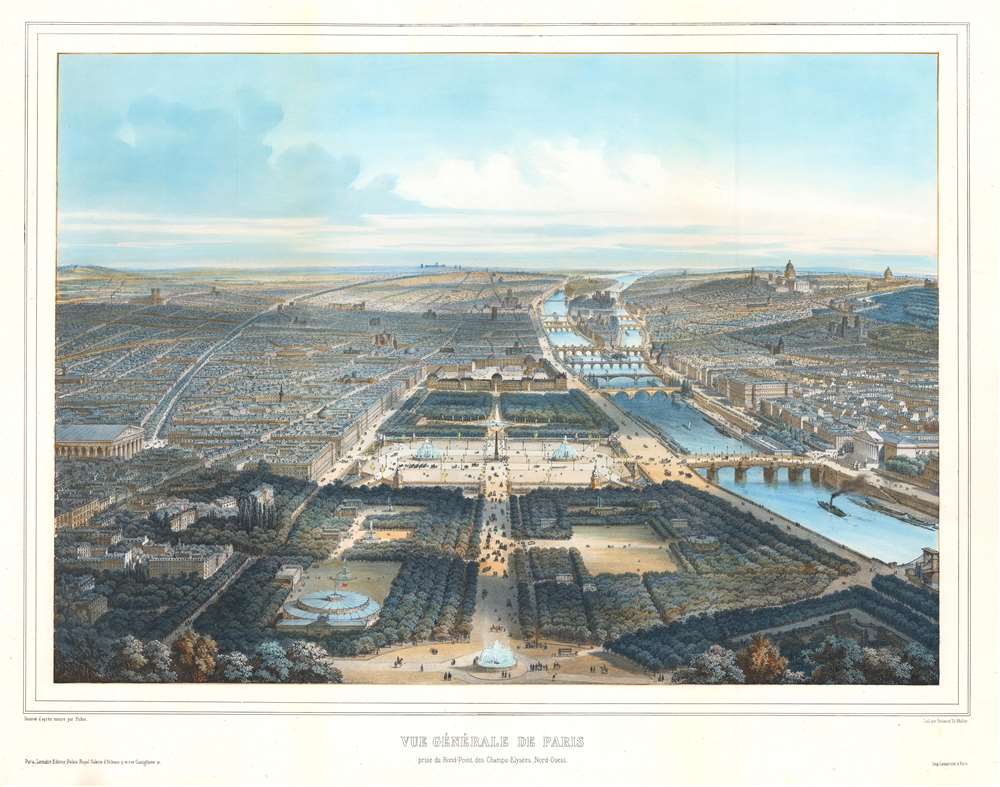1897 Fichot Bird's-Eye View Map of Paris, France
VueGeneraleParis-fichot-1897
Title
1897 (undated) 18.25 x 23 in (46.355 x 58.42 cm)
Description
The Palais de l'Industrie
Illustrating Paris during a period of a few months in early 1897, the empty field in the foreground on the right used to be home to the Palais de l'Industrie. The Palais, built for the 1855 Exposition Universelle in Paris, welcomed not only that 'Expo' but also the 1878 and 1889 Exposition Universelle. It also hosted Paris's annual art salon from 1857 until 1897. The building was demolished in 1897 to make way for the Petit Palais and the Grand Palais, which were built for the 1900 Exposition Universelle, and are still a fixture of Paris's architecture.Chromolithography
Chromolithography, sometimes called oleography, is a color lithographic technique developed in the mid-19th century. The process involved using multiple lithographic stones, one for each color, to yield a rich composite effect. Oftentimes, the process would start with a black basecoat upon which subsequent colors were layered. Some chromolithographs used 30 or more separate lithographic stones to achieve the desired product. Chromolithograph color could also be effectively blended for even more dramatic results. The process became extremely popular in the late 19th and early 20th centuries when it emerged as the dominant method of color printing. The vivid color chromolithography produced made it exceptionally effective for advertising and propaganda imagery.Publication History and Census
This view was drawn by Michel Charles Fichot, lithographed by Fichot and Thomas Muller, and printed by Rose-Joseph Lemercier c. 1896. This is the only known cataloged example.CartographerS
Michel-Charles Fichot (June 6, 1817 - July 7, 1903) was a French artist, illustrator, painter, architect, and lithographer. Born in Troyes, he studied architecture at the École des Beaux-Arts in Paris. Fichot is responsible for hundreds of decorative prints, most city views and architectural views, and exhibited at the Paris Salon between 1841 and 1897. More by this mapmaker...
Rose-Joseph Lemercier (June 29, 1803 - 1887) was a French photographer, lithographer, and printer. One of the most important Parisian lithographers of the 19th century, Lemercier was born in Paris into a family of seventeen children. His father was a basket maker, and he even began working as a basket maker at the age of fifteen, but Lemercier was drawn to lithography and printing and soon entered into an apprenticeship with Langlumé, where he worked from 1822 until 1825. After working for a handful of other printers, Lemercier started his own firm in 1828 at 2, rue Pierre Sarrazin with only one printing press. He subsequently moved a few more times before arriving at 57, rue de Seine, where he founded the printing firm Lemercier and Company. He created the firm Lemercier, Bénard and Company in 1837 with Jean François Bénard. Lemercier bought out Bénard's share in the firm in 1843 and, since his two sons died at a young age, he decided to bring his nephew Alfred into the business beginning in 1862, who would progressively take on more and more responsibility in running the firm. Between 1850 and 1870, Lemercier's firm was the largest lithographic company in Paris. The firm began to decline in prestige in the early 1870s, and, after Lemercier's death in 1887, its descent only quickened. It is unclear when the firm closed, but Alfred directed the firm until his death in 1901. Learn More...

